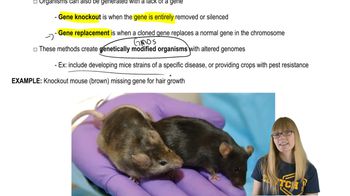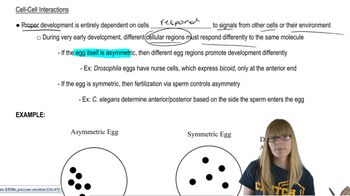Which of the following is not a germ layer formed during gastrulation?
Table of contents
- 1. Introduction to Genetics51m
- 2. Mendel's Laws of Inheritance3h 37m
- 3. Extensions to Mendelian Inheritance2h 41m
- 4. Genetic Mapping and Linkage2h 28m
- 5. Genetics of Bacteria and Viruses1h 21m
- 6. Chromosomal Variation1h 48m
- 7. DNA and Chromosome Structure56m
- 8. DNA Replication1h 10m
- 9. Mitosis and Meiosis1h 34m
- 10. Transcription1h 0m
- 11. Translation58m
- 12. Gene Regulation in Prokaryotes1h 19m
- 13. Gene Regulation in Eukaryotes44m
- 14. Genetic Control of Development44m
- 15. Genomes and Genomics1h 50m
- 16. Transposable Elements47m
- 17. Mutation, Repair, and Recombination1h 6m
- 18. Molecular Genetic Tools19m
- 19. Cancer Genetics29m
- 20. Quantitative Genetics1h 26m
- 21. Population Genetics50m
- 22. Evolutionary Genetics29m
14. Genetic Control of Development
Early Developmental Steps
Problem 1d
Textbook Question
In the discussion, we have focused on large-scale as well as the inter- and intracellular events that take place during embryogenesis and the formation of adult structures. In particular, we discussed how the adult body plan is laid down by a cascade of gene expression, and the role of cell–cell communication in development. Based on your knowledge of these topics, answer several fundamental questions:
How did we learn about the levels of gene regulation involved in vulval development in C. elegans?
 Verified step by step guidance
Verified step by step guidance1
Understand the context of vulval development in C. elegans: Vulval development in the nematode C. elegans is a well-studied model for understanding gene regulation and cell signaling during development. It involves a cascade of gene expression and cell-cell communication that determines the fate of specific cells.
Review the experimental approaches used to study gene regulation: Researchers used genetic screens to identify mutants with defects in vulval development. These screens helped pinpoint genes involved in the process, such as the lin-3 gene (encoding a signaling molecule) and let-23 gene (encoding a receptor).
Examine the role of signaling pathways: The Ras signaling pathway was found to play a critical role in vulval development. Researchers studied how the interaction between signaling molecules and receptors regulates gene expression in the vulval precursor cells.
Analyze cell-cell communication: Laser ablation experiments were conducted to remove specific cells and observe the effects on vulval development. These experiments demonstrated the importance of cell-cell communication in determining cell fates.
Integrate findings to understand gene regulation levels: By combining genetic, molecular, and cellular approaches, researchers identified multiple levels of gene regulation, including transcriptional control, signal transduction, and feedback mechanisms, that coordinate vulval development in C. elegans.
 Verified video answer for a similar problem:
Verified video answer for a similar problem:This video solution was recommended by our tutors as helpful for the problem above
Video duration:
2mPlay a video:
Was this helpful?
Key Concepts
Here are the essential concepts you must grasp in order to answer the question correctly.
Gene Regulation
Gene regulation refers to the mechanisms that control the expression of genes, determining when and how much of a gene product is produced. In the context of development, it is crucial for orchestrating the timing and spatial patterns of gene expression, which ultimately shapes the organism's body plan. Understanding gene regulation is essential for studying processes like vulval development in C. elegans, where specific genes must be activated or repressed at precise stages.
Recommended video:
Guided course

Review of Regulation
C. elegans as a Model Organism
C. elegans, a small nematode worm, is widely used as a model organism in developmental biology due to its simple anatomy, transparent body, and well-mapped genome. Researchers have utilized C. elegans to investigate genetic pathways and cellular processes, including vulval development, allowing for insights into gene function and regulation. Its ease of manipulation and observation makes it an ideal system for studying the genetic basis of development.
Recommended video:
Guided course

Transgenic Organisms and Gene Therapy
Cell–Cell Communication
Cell–cell communication is a fundamental process in development, where cells send and receive signals to coordinate their behavior and fate. In vulval development of C. elegans, signaling pathways, such as the EGF (Epidermal Growth Factor) pathway, play a critical role in determining cell fate and patterning. Understanding these communication mechanisms is vital for elucidating how cells interact to form complex structures during embryogenesis.
Recommended video:
Guided course

Cell-cell interactions

 3:46m
3:46mWatch next
Master Drosophilia Development with a bite sized video explanation from Kylia
Start learningRelated Videos
Related Practice
Multiple Choice
369
views
1
rank
